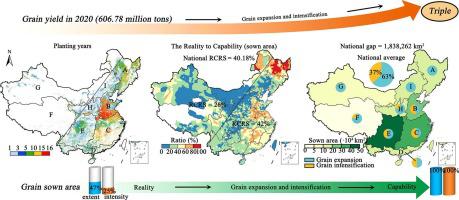当前位置:
X-MOL 学术
›
Agric. Syst.
›
论文详情
Our official English website, www.x-mol.net, welcomes your feedback! (Note: you will need to create a separate account there.)
Unveiling grain production patterns in China (2005–2020) towards targeted sustainable intensification
Agricultural Systems ( IF 6.6 ) Pub Date : 2024-02-02 , DOI: 10.1016/j.agsy.2024.103878 Bingwen Qiu , Zeyu Jian , Peng Yang , Zhenghong Tang , Xiaolin Zhu , Mingjie Duan , Qiangyi Yu , Xuehong Chen , Miao Zhang , Ping Tu , Weiming Xu , Zhiyuan Zhao
Agricultural Systems ( IF 6.6 ) Pub Date : 2024-02-02 , DOI: 10.1016/j.agsy.2024.103878 Bingwen Qiu , Zeyu Jian , Peng Yang , Zhenghong Tang , Xiaolin Zhu , Mingjie Duan , Qiangyi Yu , Xuehong Chen , Miao Zhang , Ping Tu , Weiming Xu , Zhiyuan Zhao

|
Long-term historical information on national-scale grain production is critical for ensuring food security but often limited by the lack of geospatial data. This study aims to conduct the first systematic investigation of grain Cropping Patterns (CP) in China over the past two decades, shedding light on the roles of grain expansion and intensification in sustainable agriculture. This study proposes a framework to fully characterize grain production patterns considering crop types, cropping intensity and patterns based on spatiotemporal continuous ChinaCP datasets (2005–2020). Four indicators were developed for measuring the Reality to Capability Ratio (RCR) of grain production regarding the total yield and sow area, the cropland extent and cropping intensity. The capability of grain production was derived based on grain cultivation history. There was a huge gap between the reality and capability of grain production in China, which varied with grain crop types and cropping patterns. At national level, a vast majority (96%) of cropland was capable of grain production, and two fifths of cropland quantified for double grain cropping. However, only 46.65% and 24.89% of the capability was implemented for grain or double-grain cropping in 2020. Maize, rice, and wheat was ever cultivated in 76.88%, 57.05%, and 25.18% of national cropland, respectively. Winter wheat plays an important role in stabilizing grain production by double grain cropping, accounting for 7/8 continuously grain-cultivated areas. However, the RCR of double rice was only 7% in 2020. Bridging these gaps could potentially triple grain production, however, achieving this increase poses challenges due to a series of constraints related to cropland fraction, topographic conditions and lack of agricultural labors along with rapid urbanization. This study found that there was a continuous Northeastward movement & countryside shift in grain production. Continuous support for long-term active agricultural systems is crucial to ensure sustainable grain production in China, with a special emphasis on key grain productive regions, considering targeted cropping patterns and regional disparities. This study enhances our understanding of grain production systems in China based on long-term cultivation histories. Findings can inform the development of more geographic-targeted policies concerning grain cropping intensifications to ensure food security and environmental sustainability in developing countries. The long term spatiotemporal continuous CPChina datasets during 2005-2020 was are publicly accessed at: .
更新日期:2024-02-02



























 京公网安备 11010802027423号
京公网安备 11010802027423号